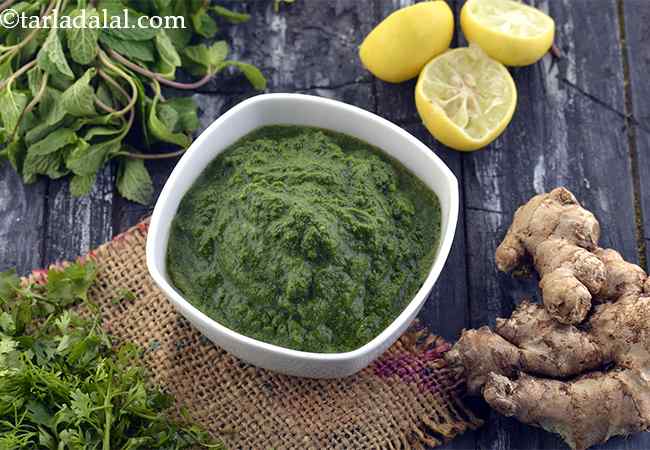Uttapam recipe makes 10 uttapam of 45 grams each.
59 calories for 1 uttapam of Healthy Uttapam, Cholesterol 1.6 mg, Carbohydrates 5.4g, Protein 2.6g, Fat 3.1g. Find how much fibre, iron, calcium, zinc, magnesium, phosphorus, sodium, potassium, folic acid is present in Healthy Uttapam.
See healthy uttapam recipe | diabetic friendly soya uttapam | oats soya uttapam |
Is Uttapam healthy ?
Yes.
What's good.
Oats : Oats are a great source of protein for Vegetarians. It is rich in soluble fibre (to make it good for diabetics), which helps lower blood LDL cholesterol, the so-called "Bad" cholesterol. Whole Oats have an antioxidant called Avenanthramide (a polyphenol from oats) which helps lower blood pressure levels. Soluble fibre absorbs water and swells and to become gel like substance which helps in the absorption of nutrients like B Vitamins and minerals like Magnesium and Zinc which are key to a good heart. See here why oats are good for you?
Soya flour : Soy flour is rich in vitamins, minerals, isoflavones and lecithin, nutrients proven to help lower cholesterol, prevent cancer and loss of bone mass. Soy is strongly recommended for diabetics, expectant mothers, growing children, cardiac patients, weight-watchers and the aged. A 100 percent vegetarian high quality protein source that does wonders for young and old. Especially great for growing children.
Curd + Low fat Curds, hung curds : Curds help in digestion as it has very good bacteria. Probiotics in curds acts as a mild laxative but, in case of diarrhoea and dysentery, it is a boon, if curd is used with rice. Curd is one of the richest sources of protein, calcium and minerals. They help in weight reduction, good for your heart and build immunity. Being low in sodium, it is safe to be eaten by individuals with high blood pressure. The only difference between curds and low fat curds is the fat level. Note that one cup curds gives half cup hung curds. Read the benefits of curds to include in your daily diet.
Onions (pyaz, kanda) : Raw onions are a very valuable source of vitamin C – the immune building vitamin. Along with other phytonutrients from onions, it helps to build WBC (white blood cells) which serves as a line of defence against illness. Yes, it’s a source of many antioxidants, the most important one amongst them being Quercetin. The quercetin in Onions promotes production of HDL (good cholesterol) and lowers total cholesterol in the body. The sulphur in onions act as a blood thinner and prevents blood clotting too. This in turn would lower blood pressure and good for heart, diabetics. Read the benefits of onions.
Tomatoes ( Cherry tomatoes, Yellow tomatoes ) : Tomatoes are extremely rich source of Lycopene. Tomatoes are a powerful antioxidant, super rich in Vitamin C, good for heart. Tomatoes are a Pregnant woman's friend and are rich in Folate or Folic Acid which helps your body to produce and maintain new cells, especially red blood cells. Read about 13 amazing benefits of tomatoes.
Can diabetics, heart patients and over weight individuals have uttapam ?
Yes. Oats are a great source of protein for Vegetarians. It is rich in soluble fibre (to make it good for diabetics), which helps lower blood LDL cholesterol, the so-called "Bad" cholesterol. Whole Oats have an antioxidant called Avenanthramide (a polyphenol from oats) which helps lower blood pressure levels. Soluble fibre absorbs water and swells and to become gel like substance which helps in the absorption of nutrients like B Vitamins and minerals like Magnesium and Zinc which are key to a good heart
Can healthy individuals have uttapam ?
Yes. Soy flour is rich in vitamins, minerals, isoflavones and lecithin, nutrients proven to help lower cholesterol, prevent cancer and loss of bone mass.
What to serve uttapam with ?
Serve it with a healthy sambar recipe or coconut chutney. Read which idlis and dosas are healthy?

Coconut chutney
OR
Have this with nutritious green chutney recipe which has ZERO sugar used in it made with mint leaves, onions and coriander or green chutney recipe. Coconut based options are healthy coconut chutney made from coconut and coriander and coconut coriander green chutney for idlis dosa uttapam vada.

Green Chutney, How To Make Green Chutney Recipe
Uttpam is rich in below macronutrients, vitamins and minerals given in descending order (highest to lowest).
Serving size is 2 uttpams.
- Vitamin B1 (Thiamine) : Vitamin B1 protects nerves, helps in carbohydrate metabolism, prevents heart diseases and helps produce red blood cells. Indian Foods rich in B1 are Flax seeds (alsi), Sunflower seeds, Sesame seeds, Garden cress seeds (halim), Capsicum, Wheat flour, Chana dal, moong, walnuts, masoor dal, brown rice, jowar, bajra. 20% of RDA.
- Vitamin B2 (riboflavin) : Vitamin B2 enables the production of red blood cells that contribute to the rise in your energy levels. So have more milk, curds, eggs and green leafy vegetables. 18% of RDA.
- Phosphorus : Phosphorus rich Indian foods works closely with calcium to build bones. Phosphorus rich Indian foods like dairy products ( milk, paneer, curd), nuts, seeds, jowar, bajra, moong, matki, oats, ragi, wheat flour etc. 18% of RDA.
- Folic Acid (Vitamin B9): Folic acid is an essential vitamin required throughout pregnancy. Folic acid rich Indian foods (kabuli chana, chana dal, yellow moong dal, urad dal, tooval dal, til ). 16% of RDA.
- Magnesium : Magnesium is required for formation of bones and teeth. It helps in the metabolism of calcium and potassium. magnesium rich Indian foods like leafy vegetables (palak, broccoli, kale), pulses ( rajma, chawli, moong ), nuts (walnuts, almonds) , cereals ( jowar, bajra, whole wheat flour, dalia). 16% of RDA.